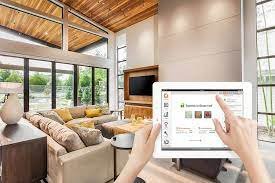In a world where security concerns are on the rise, ensuring the safety of your home and loved ones has never been more crucial. A home security system not only acts as a deterrent to potential intruders but also provides invaluable peace of mind. In this article, we will guide you through the process of installing a home security system, offering insights into various components, types, and considerations to enhance the safety of your residence.
Understanding the Types of Home Security Systems
The first step in installing a home security system is understanding the available options:
- Wired vs. Wireless Systems: Evaluate the pros and cons of wired and wireless systems to choose the one that aligns with your preferences and home structure.
- Components of a Comprehensive System: Familiarize yourself with the essential components, including cameras, motion sensors, alarms, and access control systems.
- Integration with Smart Home Technology: Explore the integration of your security system with smart home technology for added convenience and control through mobile apps and automation features.
Assessing Home Security Needs
Before diving into the installation process, assess your home’s unique security needs:
- Identifying Vulnerable Areas: Conduct a thorough evaluation of vulnerable areas, such as entry points, windows, and blind spots, to determine the optimal placement of security devices.
- Tailoring the System: Customize your security system based on specific concerns, whether it’s burglary, fire, or carbon monoxide detection.
- Additional Features: Consider additional features, such as environmental monitoring, to create a comprehensive security setup.
Choosing the Right Security Cameras
Selecting the right security cameras is crucial for effective surveillance:
- Types of Cameras: Explore different types of security cameras, such as dome cameras, bullet cameras, and PTZ cameras, each offering unique functionalities.
- Placement Strategies: Strategically place cameras to cover key areas, ensuring maximum coverage and visibility.
- High-Resolution and Night Vision: Prioritize cameras with high-resolution capabilities and night vision to capture clear footage in various lighting conditions.
Motion Sensors and Alarms
Motion sensors and alarms play a pivotal role in detecting and deterring intruders:
- Detecting Intruders: Understand how motion sensors work to detect suspicious movement and trigger alarms.
- Choosing the Right Alarm System: Select an alarm system that suits your preferences, whether it’s loud sirens, silent alarms, or a combination of both.
- Integration with Monitoring Services: Consider integrating alarms with professional monitoring services for immediate response in case of an emergency.
Access Control Systems
Enhance access control for your home with modern technology:
- Smart Locks: Explore smart locks and keyless entry options for convenient and secure access.
- Biometric Access Control: Consider biometric access control for an additional layer of security.
- Remote Access: Embrace remote access and monitoring through mobile apps for increased flexibility and control.
Professional Monitoring Services
Consider the benefits of professional monitoring for enhanced security:
- Immediate Response: Professional monitoring services provide immediate response in case of security breaches or emergencies.
- Choosing a Reputable Service: Research and choose a reputable monitoring service with a proven track record in the industry.
- Cost Considerations: Evaluate the cost of professional monitoring and subscription plans, considering it as an investment in your home’s safety.
DIY Installation vs. Professional Installation
Decide whether to opt for a do-it-yourself installation or seek professional assistance:
- Pros and Cons of DIY: Understand the advantages and challenges of a DIY installation, considering your technical skills and available time.
- Benefits of Professional Installation: Professional installation ensures a seamless setup, optimal placement of devices, and adherence to industry best practices.
- System Maintenance: Considerations for ongoing system maintenance and troubleshooting, depending on your chosen installation approach.
Smart Home Integration and Automation
Explore the integration of your home security system with smart home devices:
- Connecting Devices: Integrate security systems with other smart home devices, creating a cohesive and interconnected home environment.
- Automation Features: Implement automation features for lights, thermostats, and doorbell cameras, enhancing overall home convenience and security.
- User-Friendly Operation: Ensure that the integrated system is user-friendly, allowing easy control and monitoring through a central platform or mobile app.
Cost Considerations and Budgeting
Understand the financial aspects associated with installing a home security system:
- Upfront Costs: Be aware of the upfront costs, including the purchase of devices, installation fees, and any additional equipment required.
- Monthly Monitoring Fees: Consider monthly monitoring fees and subscription plans, balancing cost-effectiveness with desired features.
- Value vs. Investment: View your home security system as an investment in safety and peace of mind rather than a mere expense.
Common Challenges and How to Address Them
Anticipate and address common challenges associated with home security systems:
- Dealing with False Alarms: Implement strategies to minimize false alarms, such as proper placement of motion sensors and regular system testing.
- Troubleshooting Technical Issues: Be prepared to troubleshoot technical issues promptly, seeking assistance from customer support if needed.
- Regular Maintenance Tips: Establish a routine for regular system maintenance, including software updates, battery replacements, and device checks.
Tips for Maximizing Home Security
Ensure the ongoing effectiveness of your home security system with these tips:
- Updating Passwords: Regularly update passwords and access credentials to prevent unauthorized access.
- Communication with Household Members: Communicate security measures with all household members, ensuring everyone is aware of system protocols.
- Staying Informed: Stay informed about advancements in home security technology, considering upgrades or additions to enhance your system’s capabilities.
Conclusion
Installing a home security system is a proactive step towards safeguarding your home and ensuring peace of mind for you and your family. By understanding the types of systems, assessing your specific needs, and making informed choices about devices and monitoring services, you can create a robust security setup tailored to your home. Embrace the integration of smart home technology, weigh the costs against the benefits, and stay vigilant in addressing challenges for an effective and reliable home security solution. Ultimately, the investment in a home security system is an investment in the safety and well-being of your loved ones.
Frequently Asked Questions (FAQs)
- Q: Can I install a home security system myself, or is professional installation recommended? A: You can choose to install a home security system yourself with a DIY kit, but professional installation ensures proper setup, optimal device placement, and adherence to industry standards.
- Q: What features should I prioritize when selecting security cameras for my home? A: Prioritize high-resolution cameras with night vision capabilities, consider the type of camera (dome, bullet, PTZ), and ensure strategic placement for comprehensive coverage.
- Q: Are professional monitoring services worth the cost? A: Professional monitoring services offer immediate response in emergencies, making them valuable for enhanced security. Consider your priorities and budget when deciding.
- Q: How can I prevent false alarms with my home security system? A: Minimize false alarms by ensuring proper placement of motion sensors, conducting regular system tests, and addressing any technical issues promptly.
- Q: What role does smart home integration play in a home security system? A: Smart home integration enhances the functionality of a security system by allowing seamless control, automation features, and connectivity with other smart devices for an interconnected home environment.







